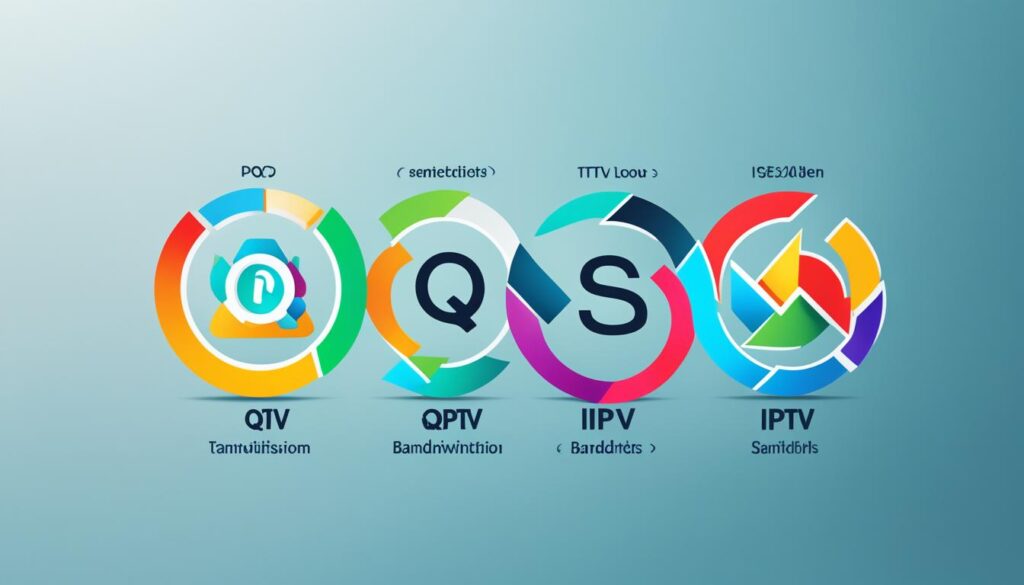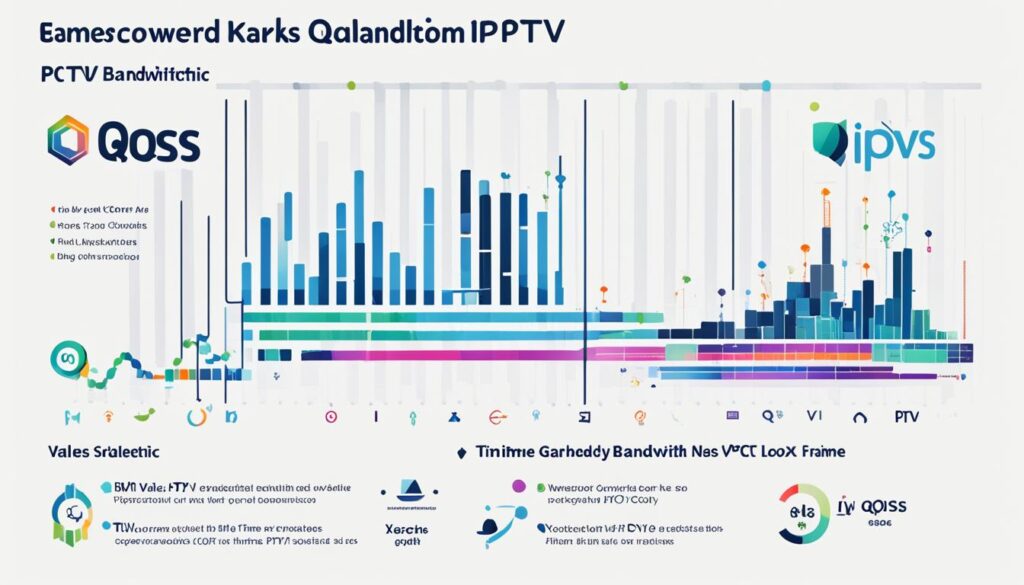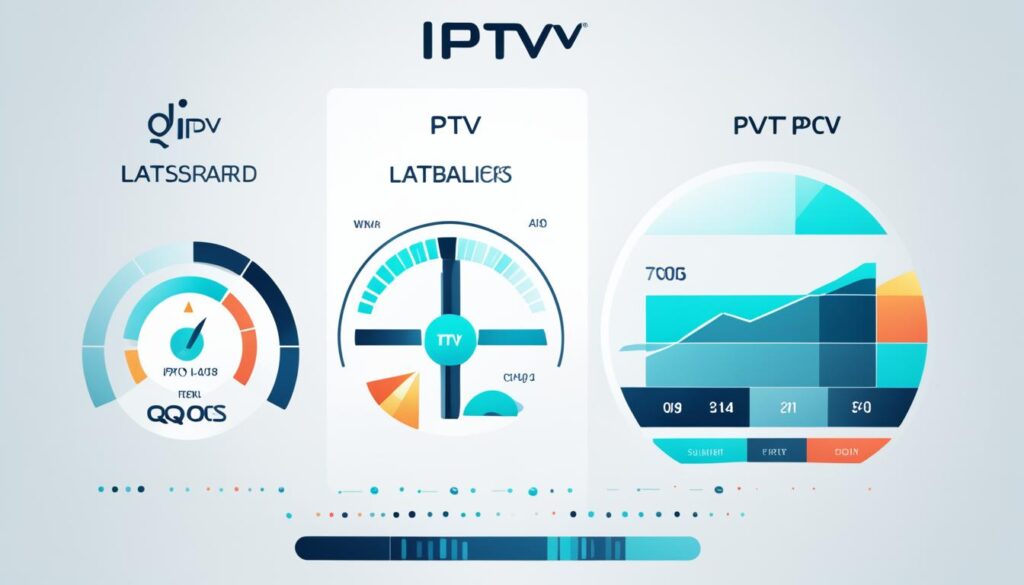Did you know that IPTV services are expected to reach a market value of $117.07 billion by 2027? With the increasing popularity of IPTV providers and the growing demand for IPTV streaming, ensuring a high-quality viewing experience has become more important than ever.
IPTV, or Internet Protocol Television, offers a range of benefits such as personalized viewing experiences and on-demand content. However, the quality of IPTV service can be influenced by factors like signal strength, reliability, and overall performance. To deliver a seamless and enjoyable IPTV experience, providers need to focus on optimizing network performance and implementing effective Quality of Service (QoS) management.
Key Takeaways:
- IPTV services are projected to reach a market value of $117.07 billion by 2027.
- Optimizing network performance and implementing effective QoS management is crucial for a high-quality IPTV experience.
- Factors like signal strength, reliability, and overall performance can impact the quality of IPTV service.
- Providers can prioritize IPTV traffic, implement traffic prioritization mechanisms, and optimize network capacity to ensure a minimum QoS level.
- Monitoring, troubleshooting, and diagnosing QoS issues are essential for maintaining a reliable IPTV system.
IPTV QoS Standards
Several standards and recommendations have been established to define the Quality of Service (QoS) requirements and parameters for IPTV (Internet Protocol Television).
The International Telecommunication Union (ITU) has played a significant role in developing IPTV QoS standards. One of the key standards is ITU-T Y.1901, which specifies a comprehensive QoS framework and architecture for IPTV systems.
Another essential standard is ITU-T G.1010, which defines QoS categories and factors specifically tailored for multimedia applications, including IPTV.
ITU-T G.1070 provides an opinion model for estimating the end-user Quality of Experience (QoE) in video-telephony applications. While primarily designed for video-telephony, this model can be applied to IPTV to enhance the user experience.
In addition to ITU standards, the European Telecommunications Standards Institute (ETSI) has released ETSI TS 102 034, which covers QoS parameters and measurement methods for Digital Video Broadcasting over IP networks.

These standards and recommendations play a crucial role in ensuring consistent and high-quality IPTV services. They provide guidelines for establishing the QoS framework, defining relevant QoS categories, evaluating user experience, and establishing measurable parameters for QoS management.
Please refer to the table below for a summary of the IPTV QoS standards:
| Standard | Organization |
|---|---|
| ITU-T Y.1901 | International Telecommunication Union (ITU) |
| ITU-T G.1010 | International Telecommunication Union (ITU) |
| ITU-T G.1070 | International Telecommunication Union (ITU) |
| ETSI TS 102 034 | European Telecommunications Standards Institute (ETSI) |
By adhering to these standards and implementing their recommendations, IPTV service providers can ensure optimal QoS management and deliver an exceptional viewing experience to their customers.
IPTV QoS Metrics
When it comes to assessing the performance and reliability of IPTV services, several key metrics known as IPTV QoS metrics come into play. These metrics help evaluate the quality of the IPTV streaming experience and enable service providers to optimize stream quality for users.
Packet Loss
One of the crucial metrics in IPTV QoS is packet loss, which indicates the number of lost or discarded packets during transmission. High packet loss can result in interruptions and degrade the overall streaming experience.
Jitter
Jitter refers to the variation in packet delay, which can lead to disruptions in the flow of the video stream. By measuring and minimizing jitter, service providers can ensure smoother playback and consistent video quality.
Delay
Delay, also known as latency, is the time taken for packets to travel from the source to the destination. Excessive delay can cause buffering issues and negatively impact the real-time nature of IPTV streaming.
Bitrate
Bitrate measures the amount of data transmitted per unit of time. Higher bitrates typically result in better video quality, while lower bitrates can lead to pixelation and reduced clarity in the streaming content. It is crucial to optimize the bitrate to achieve the desired viewing experience.
Media Delivery Index (MDI)
The Media Delivery Index (MDI) is a comprehensive metric for assessing the overall stream quality. It takes into account factors such as jitter buffer requirements and packet loss rate to provide a holistic evaluation of the IPTV stream’s performance.
Table: IPTV QoS Metrics
| Metric | Description |
|---|---|
| Packet Loss | The number of lost or discarded packets during transmission. |
| Jitter | Variation in packet delay, which can disrupt the video stream. |
| Delay | The time taken for packets to travel from source to destination. |
| Bitrate | Amount of data transmitted per unit of time. |
| Media Delivery Index (MDI) | Comprehensive metric assessing stream quality based on jitter buffer requirements and packet loss rate. |
These QoS metrics play a crucial role in evaluating the performance of IPTV services and enable service providers to optimize the stream quality for an enhanced viewing experience. By measuring and monitoring these metrics, providers can ensure a reliable and high-quality IPTV streaming service.

IPTV QoS Monitoring
IPTV QoS monitoring plays a crucial role in ensuring the quality and performance of IPTV services. By collecting, analyzing, and reporting on Quality of Service (QoS) metrics, service providers can detect and diagnose network and application issues, allowing for timely resolution and improved user experience.
There are different approaches to IPTV QoS monitoring, each with its own benefits and considerations. Let’s explore three main types of monitoring: passive monitoring, active monitoring, and hybrid monitoring.
Passive Monitoring
Passive monitoring involves capturing IPTV packets without modifying them, allowing for real-time measurement of QoS metrics. This method provides valuable insights into the actual performance of the IPTV network, including factors such as packet loss, delay, and jitter. However, passive monitoring can be resource-intensive and requires high processing capabilities.
Active Monitoring
Active monitoring, on the other hand, involves the deliberate generation and transmission of synthetic IPTV packets or probes through the network. By simulating IPTV traffic, service providers can measure specific QoS metrics and identify potential bottlenecks or issues within the network. However, active monitoring introduces additional traffic, which may impact the overall network performance.
Hybrid Monitoring
Hybrid monitoring combines the strengths of both passive and active monitoring techniques. By utilizing a combination of packet capture analysis and synthetic traffic generation, service providers gain comprehensive insights into the IPTV network’s performance. Hybrid monitoring provides a more thorough understanding of QoS metrics, enabling effective troubleshooting and optimization. However, this approach typically entails higher costs in terms of hardware and software.

Overall, effective IPTV QoS monitoring requires a balanced approach that suits the specific needs and infrastructure of the IPTV service provider. By employing the appropriate monitoring techniques, service providers can proactively identify and resolve potential issues, ensuring a high-quality IPTV viewing experience for their customers.
| Monitoring Type | Advantages | Considerations |
|---|---|---|
| Passive Monitoring | Real-time measurement of QoS metrics | High processing resources required |
| Active Monitoring | Identifies specific network issues | Introduces additional traffic |
| Hybrid Monitoring | Comprehensive insights into QoS metrics | Higher costs |
IPTV QoS Troubleshooting
When it comes to IPTV Quality of Service (QoS), troubleshooting is key to maintaining a reliable and seamless viewing experience for users. By identifying, isolating, and resolving root causes of QoS problems, service providers can ensure optimal performance. Here are the steps involved in IPTV QoS troubleshooting:
1. Baselining and Benchmarking
Baseline and benchmark abnormal QoS events to establish a performance standard for comparison. This helps in identifying deviations and potential issues that may affect the IPTV service quality.
2. Correlation and Isolation
Correlate and isolate the metrics across different layers of the delivery chain. By examining various factors such as network latency, bandwidth utilization, and server performance, service providers can pinpoint the root cause of QoS problems.
3. Packet Capture Analysis and Error Detection
Utilize packet capture analysis and error detection tools to analyze the captured data and identify anomalies. This involves inspecting network packets, decoding protocols, and detecting errors or irregularities that may impact the IPTV service quality.
4. Root Cause Resolution
Resolve the identified problems by optimizing network configurations, tuning application settings, performing firmware updates, and actively seeking customer support feedback. Service providers work to eliminate the root causes and ensure a seamless IPTV experience for users.
By following these troubleshooting steps, service providers can proactively address QoS issues and deliver an optimized IPTV experience. Implementing effective troubleshooting techniques assists in resolving problems before they escalate and helps maintain a high level of customer satisfaction.

Impacts of IPTV Traffic on Other Applications
IPTV traffic can have significant impacts on other applications in home networks. When IPTV traffic is present, the TCP congestion control mechanism may not function optimally, resulting in decreased performance for other applications. This can lead to buffering, latency, and reduced overall network efficiency.
However, it is crucial to improve TCP performance in the presence of IPTV traffic to ensure a smooth experience for all applications. One approach to enhancing TCP performance is by optimizing the response to IPTV traffic, allowing for better network utilization and improved Quality of Service (QoS) for both IPTV and other applications.

Illustration depicting the impact of IPTV traffic on other applications in a home network.
With the increasing popularity of IPTV services and the associated rise in IPTV traffic, it is essential to address the challenges posed to other applications. By strategically managing and optimizing the network, service providers can minimize the adverse effects of IPTV traffic on other applications and ensure a seamless online experience for users.
To achieve this, advancements in TCP congestion control algorithms can be implemented, which specifically account for the presence of IPTV traffic. These improved algorithms dynamically adapt to network conditions and prioritize different types of traffic, mitigating congestion and maximizing performance.
Furthermore, network optimization techniques such as traffic shaping and bandwidth allocation can be employed to allocate the necessary resources for both IPTV and other applications, ensuring equitable performance across the network.
By considering the impacts of IPTV traffic on other applications and proactively implementing measures to enhance TCP congestion control and overall network performance, service providers can deliver a seamless user experience for all internet services.
| Impacts of IPTV Traffic on Other Applications | Improvement Strategies |
|---|---|
|
|
Queueing Model for IPTV Systems
A queueing model is a valuable analytical tool used to study and optimize IPTV systems, ensuring efficient Quality of Service (QoS) management. With IPTV operating in a closed network environment, service providers have the ability to control and prioritize QoS factors effectively.
One critical aspect of IPTV systems is scalability. As the demand for IPTV services continues to grow, the use of multicast technology plays a vital role in achieving scalability. By leveraging multicast technology, service providers can efficiently transmit IPTV content to a large number of viewers simultaneously, ensuring a seamless viewing experience and maintaining QoS standards.
Advancements in video encoding and internet access technology have further contributed to the feasibility of transmitting VHS-quality or even high-definition (HDTV) video over IP networks. This has significantly enhanced the quality and performance of IPTV systems, enabling viewers to enjoy high-resolution content with exceptional clarity and detail.
Benefits of Queueing Model in IPTV Systems
By utilizing a queueing model, IPTV service providers gain valuable insights into network performance and resource utilization. This, in turn, helps optimize QoS management and enhance the overall viewing experience for IPTV users.
The queueing model enables service providers to:
- Analyze the performance of IPTV systems, identifying potential bottlenecks and areas of improvement.
- Predict and allocate resources effectively, ensuring optimal utilization and minimizing service disruptions.
- Optimize network infrastructure to accommodate increasing IPTV traffic demands while maintaining QoS standards.
- Monitor and manage network congestion, ensuring smooth and uninterrupted IPTV streaming.
Overall, the integration of a queueing model in IPTV systems plays a crucial role in ensuring scalability, efficient QoS management, and a superior viewing experience for users.
QoS Management in IPTV Systems
Quality of Service (QoS) management plays a crucial role in ensuring a seamless and reliable IPTV experience. By implementing effective QoS strategies, IPTV service providers can optimize network performance and minimize disruptions, enhancing the overall user satisfaction.
One key aspect of QoS management is network over-provisioning. This involves allocating adequate bandwidth and resources to the IPTV system to ensure a minimum QoS level. By provisioning the network capacity based on anticipated IPTV traffic demands, service providers can avoid congestion and guarantee smooth video streaming.
To further prioritize IPTV packets and minimize the impact on other internet traffic, traffic prioritization mechanisms such as Differentiated Services (Diffserv) and IEEE802.1p can be utilized. These mechanisms assign specific priority levels to IPTV packets, ensuring their timely delivery and minimizing latency.
For effective QoS management, ISPs can implement priority mechanisms at both the network and MAC (Media Access Control) layers. This enables the seamless transmission of IPTV traffic while maintaining performance for other applications.
QoS Management in IPTV Systems: Key Strategies
- Network over-provisioning: Allocating sufficient network resources to meet the demands of IPTV traffic, ensuring a minimum QoS level.
- Traffic prioritization: Utilizing mechanisms like Diffserv and IEEE802.1p to give IPTV packets higher priority, minimizing delay and optimizing QoS.
- Implementation at network and MAC layers: Incorporating priority mechanisms at both the network and MAC layers, ensuring efficient packet delivery and maintaining overall network performance.
By adopting these QoS management strategies, IPTV service providers can deliver a reliable and high-quality viewing experience to their subscribers. With an optimized network and prioritized traffic, IPTV systems can operate seamlessly, providing uninterrupted entertainment for users.
| QoS Management Strategy | Description |
|---|---|
| Network over-provisioning | Allocating adequate network resources to meet IPTV traffic demands, ensuring smooth video streaming. |
| Traffic prioritization | Assigning higher priority levels to IPTV packets using mechanisms like Diffserv and IEEE802.1p, minimizing latency and ensuring timely delivery. |
| Implementation at network and MAC layers | Incorporating priority mechanisms at both the network and MAC layers to maintain efficient packet delivery and overall network performance. |
Conclusion
In conclusion, ensuring high-quality IPTV services relies on effective Quality of Service (QoS) management and network optimization. By implementing QoS standards, service providers can prioritize IPTV traffic and ensure a minimum QoS level. This guarantees a reliable and enjoyable viewing experience for users.
Monitoring and troubleshooting IPTV QoS is essential in detecting and resolving network and application issues. Service providers can employ both passive and active monitoring techniques to collect QoS metrics and diagnose problems. Additionally, proper QoS management techniques, such as baseline benchmarking and correlation, packet capture analysis, and error detection, help optimize IPTV stream quality and resolve QoS problems.
Furthermore, the use of a queueing model in IPTV systems, combined with network over-provisioning and traffic prioritization mechanisms, facilitates network scalability and ensures a smooth IPTV experience. ISPs can optimize QoS by implementing technologies like DiffServ and IEEE802.1p to prioritize IPTV packets over other internet traffic, improving performance and reliability.
In summary, IPTV QoS plays a vital role in delivering a high-quality viewing experience. By implementing QoS standards, monitoring and troubleshooting IPTV QoS, and optimizing network performance, service providers can enhance the reliability and performance of IPTV services. With proper QoS management techniques and network optimization, challenges like scalability can be overcome, resulting in a seamless IPTV experience for users.
FAQ
What is IPTV?
What are the advantages of IPTV?
How does the quality of IPTV service get affected?
How is Quality of Service (QoS) managed in IPTV systems?
What are the QoS standards for IPTV?
What are the key QoS metrics for IPTV?
How is IPTV QoS monitored?
How is IPTV QoS troubleshooting done?
How does IPTV traffic impact other applications in home networks?
How can TCP performance be improved with IPTV traffic?
How does a queueing model help in IPTV systems?
How is QoS managed in IPTV systems?






